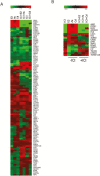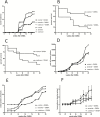Arsenite and cadmium promote the development of mammary tumors
- PMID: 31646340
- PMCID: PMC7359772
- DOI: 10.1093/carcin/bgz176
Arsenite and cadmium promote the development of mammary tumors
Abstract
Previous studies demonstrate that the heavy metal cadmium and the metalloid arsenite activate estrogen receptor-alpha in breast cancer cells by forming a high-affinity complex with the ligand-binding domain of the receptor and that environmentally relevant doses of cadmium have estrogen-like activity in vivo. The present study showed that in estrogen-receptor positive cells, arsenite and cadmium increased the global expression of estrogen-responsive genes and that an environmentally relevant dose of arsenite also had estrogen-like activity in vivo. Similar to estrogens, exposure of ovariectomized animals to arsenite induced the expression of the progesterone receptor, GREB1, and c-fos in the mammary gland and the expression of complement C3, c-fos, and cyclin D1 in the uterus and the increase was blocked by the antiestrogen ICI-182,780. When virgin female animals were fed a diet, that mimics exposure to either arsenite or cadmium, and challenged with the chemical carcinogen dimethylbenzanthracene, there was an increase in the incidence of mammary tumors and a decrease in the time to tumor onset, but no difference in the total number of tumors, tumor multiplicity, or total tumor volume. Together with published results, these data showed that environmentally relevant amounts of arsenite and cadmium had estrogen-like activity in vivo and promoted mammary tumorigenesis.
© The Author(s) 2019. Published by Oxford University Press.
Figures






References
-
- Ferlay J. et al. . (2010) Estimates of worldwide burden of cancer in 2008: GLOBOCAN 2008. Int. J. Cancer, 127, 2893–2917. - PubMed
-
- Jemal A. et al. . (2011) Global cancer statistics. CA. Cancer J. Clin., 61, 69–90. - PubMed
-
- Kampert J.B. et al. . (1988) Combined effect of childbearing, menstrual events, and body size on age-specific breast cancer risk. Am. J. Epidemiol., 128, 962–979. - PubMed
-
- Lippman M.E. (1985) Endocrine responsive cancers of man. In Williams R.H. (ed) Textbook of Endocrinology. W.B. Saunders, Philadelphia, pp. 1309–26.
Publication types
MeSH terms
Substances
Grants and funding
LinkOut - more resources
Full Text Sources
Molecular Biology Databases
Research Materials
Miscellaneous

